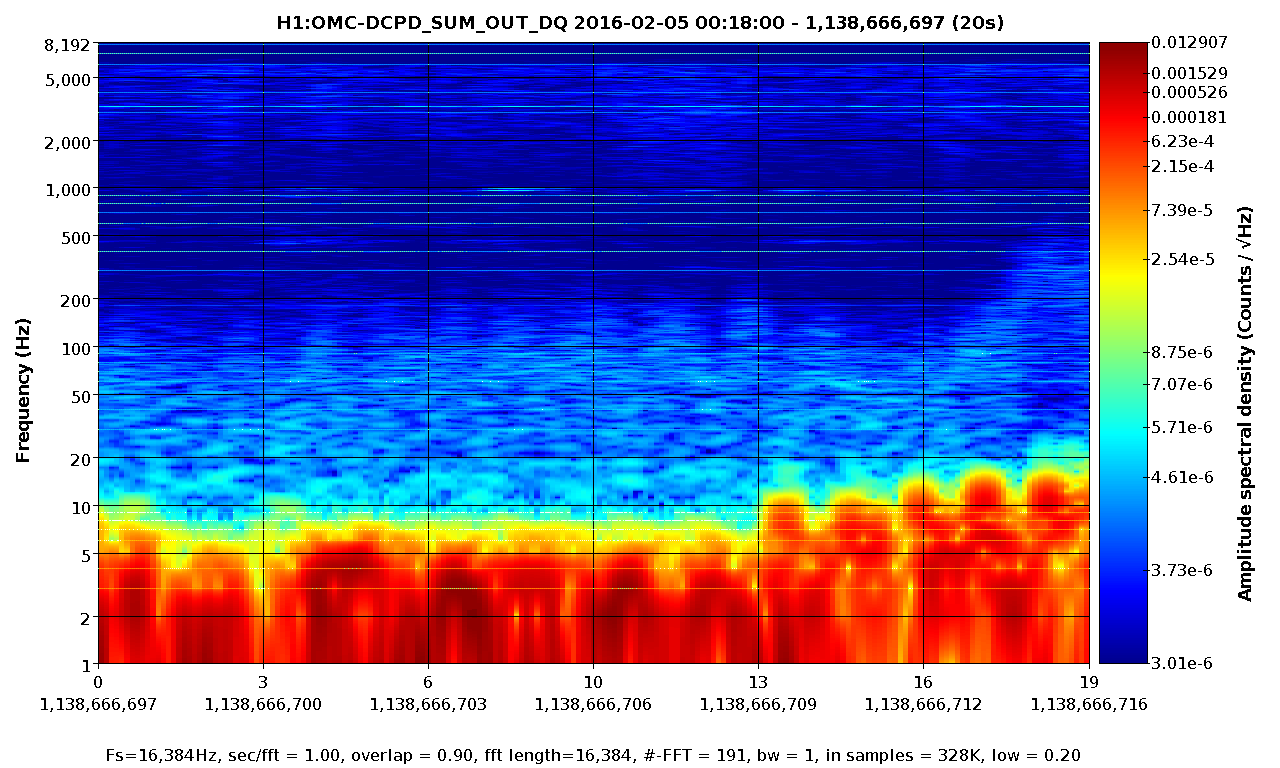Again Masayuki.Nakano reported with Stefan's account
Kiwamu, Masayuki
We measured spectrum of the OMC DCPD signals with a single bounce beam. It would help a noise budget of a DARM signal.
What we did
1. Increase the IMC power
IMC power was increased up to 21W. Also H1:PSL-POWER_SCALE_OFFSET was changed to 21.
2. Turn of the guardian of isc-lock
Requested 'DOWN' to the isc-lock guardian to not do anything during the measurement.
3.Miss align the mirrors
For leading the single bounce beam, all of mirrors were misaligned by requesting 'MISALIGN' to guardians of each mirrors except for ITMX.
4.Aligned the OM mirrors
When we got single bounce beam from IFO, there was no signal from ASC-AS-A, B, C QPDs initially. We aligned OM1,OM2,OM3,OMC suspensions with the playback data of OSEM signals
5.Locked the OMC
The servo gain, 'H1:OMC-LSC_SERVO_GAIN', was set to 10 and master gain of the OMC-ASC was set to 0.1.
The DCPD output was 34 mA.
6.Measurement (without a ISS second loop)
The power spectrum of below channels are measured. Measurement frequency was 1-7kHz and BW was 0.1 Hz. The measured channel was as below.
H1:OMC-DCPD_SUM_OUT
H1:OMC-DCPD_NULL_OUT
H1:PSL-ISS_SECONDLOOP_SUM58_REL_OUT
H1:PSL-ISS_SECONDLOOP_SUM58_REL_OUT was used as the out-of-loop sensor of the ISS.
7.Closed the ISS second loop
The ISS second loop was closed. The sensors used to gain error signal was PD1-4.
8.Measurement (with a ISS second loop)
Same measurement as step5. In addition to that, the coherence function between DCPD-SUM and SECONDLOOP_SUM was measured.
Discussion
I scaled out-of-loop sensor signals of ISS, i.e. the residual intensity noise after the ISS second loop, to the same unit as OMC-DCPD signals. The scaling factor was estimated by dividing the H1:OMC-DCPD_SUM_OUT spectrum (without ISS) by H1:PSL-ISS_SECONDLOOP_SUM58_REL_OUT spectrum (also without ISS) at 100Hz.
I scaled those spectrum both (hereafter 'both' means with and without closing ISS) by same scaling factor.
You can see the DCPD-SUM spectrum, DCPD-NULL spectrum and scaled second loop ISS out of loop sensor signals in attached plots.
The both NULL signals agree with the shot noise of a PD with 34mA signal (cyan curve) above 30Hz, and below that it would be limited by ADC noise.
About the SUM signals, it seems to consistent with the scaled intensity noise above 300 Hz. Also they have some coherence between the intensity noise and the OMC PD signal upper than 300Hz(see another plot). On the other hand, there seems to be some unknown noise below 300 Hz when the second ISS loop was closed.
Possibly this unkown noise might come from the length motion of the OMC. I attached another plot. This plot is the one of same channel(upper) and the OMC error signal with a different servo gain of OMC LSC loop. The error signal and DCPD-SUM signal seem to have similar structure around 100Hz. I haven't any analysis yet because these plots are measred after whitening filter had some trouble and we are planing to do same measurement again with whitening filter.
As Masayuki reported above, we see unexplained coherent noise on DCPDs in 10-200 Hz frequency band. However, according to an offline analysis with spectrogram, they appear to be somewhat non stationary. This indicates the existence of uncontrolled (and undesired) interferometry somewhere.
We should repeat the measurement with a different misalignment configuration.
Later, we concerned about noise artefact which can be introduced by not-quite-misaligned mirrors making scattering shelf or some sort in this measurement. To test this theory, we looked back the data in spectrogram and searched for non stationary behavior. It seems that we had two different non-stationary components; one below 10-ish Hz and the other between 10 and 200 Hz. The attached are the spectrograms produced by LIGODV web for 20 sec where we had 20 W PSL, OMC locekd with a gain of 10 and ISS closed using the PDs 1 through 4 as in-loop sensors.
In DCPD-SUM, it is clear that the component below 10 Hz was suddenly excited at t = 13 sec. Also, the shelf between 100 and 200 Hz appear to move up and down as a function of time.
Also, here are two relevant ISS signals which did not show obvious correlation with the observed non stationary behavior.











